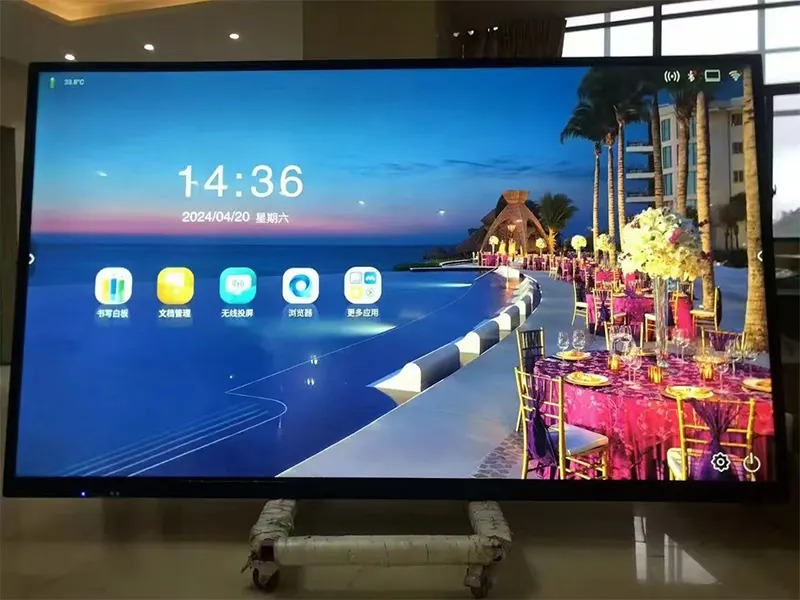How to Choose the Right Interactive Signage for Your Classroom or Office?
Interactive whiteboards are modern interactive signage solutions that empower classrooms and offices with dynamic, touch-enabled displays. In fact, digital signage is a booming field expected to exceed $29.6 billion by 2024, and the interactive whiteboard segment is growing too: it’s projected to climb from about $4.8 billion in 2024 to $7.3 billion by 2030. This concept isn’t entirely new: interactive displays date back to early touchscreen kiosks in the 1980s, and today’s interactive whiteboards continue that tradition. These smart screens combine the functions of a traditional whiteboard with advanced touchscreen technology, allowing users to write, draw, and manipulate digital content directly on the display. Using an interactive whiteboard, teachers and presenters can annotate slides, save notes instantly, and engage audiences in new ways. With such versatile displays, you may wonder: How to choose the right interactive whiteboard for your classroom or office? In this guide, we’ll highlight key features of interactive signage devices and provide tips to help you select the best interactive whiteboard solution for your needs.
Key Features to Consider in an Interactive Whiteboard
Multi-Touch and Input Options: The best interactive signage (whiteboard) supports multi-touch input so multiple users can write simultaneously. Look for at least 10-point touch capability and fine stylus support. Some high-end boards allow up to 20 separate touch points, enabling dozens of students to annotate the screen at once. Also consider whether the board recognizes both finger touch and a stylus pen for precision drawing.
Display Size & Resolution: Choose an interactive signage display with a screen large enough for your room. Typical interactive boards range from 55 inches to 86 inches or more. As a guideline, the board’s width should be about one-sixth of the farthest viewer distance (for example, a 75-inch width for a 50-foot classroom). Higher resolutions (Full HD or 4K) ensure text and images stay sharp, while anti-glare panels improve visibility under bright lights.
Connectivity & Compatibility: Verify your interactive signage display has flexible connectivity: multiple HDMI, USB, and VGA ports, plus wireless options (Wi-Fi, Bluetooth). This flexibility lets you plug in laptops, tablets, or cameras easily. Also ensure it works with your existing systems: many interactive displays can connect to videoconferencing software (Zoom, Microsoft Teams) or network drives so everyone can share screens seamlessly.
Built-In Software & Content Management: Many interactive signage displays include pre-installed tools like drawing apps, browsers, and office software. Others rely on cloud-based content management systems (CMS) to push updates. A modern CMS platform allows remote scheduling of content, useful in classrooms and digital signage settings. Ideally, choose an intuitive, cloud-enabled software suite that doesn’t require specialized IT knowledge.
Durability & Support: Commercial-grade interactive signage displays are built to run 8–12 hours per day. Look for features like tempered glass, robust frames, and 3+ year warranties. Check if there are maintenance plans or tech support offered. Because interactive signage is often installed long-term, having on-site support or easy access to replacements ensures your investment is protected.
Each of these features contributes to the overall effectiveness of an interactive signage solution. By balancing size, input technology, connectivity, and support, you can narrow down the models that best fit your needs.
Benefits of Interactive Whiteboards and Interactive Signage
Interactive Engagement: Unlike static digital signage, interactive whiteboards turn audiences into active participants. In practice, this means students and meeting attendees engage more with lessons or presentations. Many educators find that allowing direct interaction (touch, drawing) transforms a lecture into an interactive experience.
Enhanced Learning & Collaboration: Touch-driven signage boosts participation. Teams can brainstorm on the fly, with multiple people annotating documents or solving problems on-screen together . This also benefits learners of all levels, as they can literally manipulate the content they see.
Flexible, Multimedia Content: An interactive signage display can show video, animations, web content, and live data streams. Instructors or presenters can seamlessly switch between teaching slides, educational apps, and online media in real time to keep sessions dynamic. Plus, because content updates instantly, organizations save on printed materials.
Real-Time Feedback and Assessment: Many interactive signage systems include built-in quiz and polling features. Teachers can ask questions and see student responses instantly on-screen. This immediacy keeps students alert and allows instructors to adjust their teaching if learners misunderstand a concept.
Increased Retention: Hands-on, interactive learning often leads to better memory retention. Because users actively engage with the material (highlighting, dragging, writing), they remember information longer than through passive methods. Interactive signage has been shown to enhance message retention, making lessons and presentations more effective.
Overall, interactive signage solutions offer a more engaging and adaptive experience than traditional teaching or presentation tools.
Where to Use Interactive Signage
Interactive signage can serve many industries and environments. Depending on where you use it, an interactive whiteboard may function as a teaching aid, a meeting tool, a customer-facing kiosk, or a dynamic display for announcements.
Education: Teachers use them to present lessons with touch controls, and students can interact directly with content. These boards handle multimedia lessons seamlessly and support distance learning.
Corporate Offices: In business settings, interactive displays serve as digital whiteboards during meetings. Presenters can annotate slides live during video calls or workshops.
Training Centers: Any environment requiring group work benefits from interactive signage. Innovation labs, design studios, and training centers use them for brainstorming sessions where ideas are drawn and saved electronically.
Public and Retail Spaces: Interactive digital kiosks engage customers and visitors. For example, an interactive map in a mall or airport lets travelers find stores or gates quickly.From schools to offices to public venues, these displays turn passive viewing into active participation.
How to Choose the Right Interactive Whiteboard
Define Your Goals: Determine your primary use — teaching, meetings, or signage.
Room Size and Placement: Match screen size to viewing distance; avoid glare.
Budget: Consider long-term software, installation, and support costs.
Compatibility: Ensure it works with your systems and is easy to use.
Durability: Choose a commercial-grade model with a good warranty.
Conclusion
In summary, an interactive whiteboard (interactive signage display) is a powerful tool that can transform how you teach, present, or collaborate. By evaluating features such as size, touch capabilities, software, and connectivity, you can select a model that fits your environment. If you need help choosing the perfect interactive whiteboard or want more details about these products, contact us to learn more about our full lineup of interactive signage solutions and schedule a demo with our experts.
Frequently Asked Questions (FAQ)
Q: What exactly is an interactive whiteboard (interactive signage)?
An interactive whiteboard is a large touchscreen computer display used like a digital whiteboard and is a type of interactive signage. Users can write, draw, or control apps directly on the screen.
Q: How is interactive signage different from regular digital signage?
Traditional digital signage simply broadcasts information. By contrast, interactive signage invites viewers to become users who can touch or interact with the content.
Q: Can interactive whiteboards be used for remote classrooms?
Yes. Many interactive signage boards integrate with video conferencing platforms so remote participants can see and interact in real time.
Q: What features should I look for when buying an interactive whiteboard?
Key factors include screen size, touch capability, and included software. Look for multi-touch support, high resolution, and reliable connectivity.
Q: How much does an interactive whiteboard system cost?
Prices vary widely. Basic models start at a few hundred dollars, while commercial-grade displays can range from $500 to $1,000 or more per screen.
Q: How do I maintain and update an interactive whiteboard?
Regular maintenance includes cleaning the screen and updating software. Many boards auto-update when new firmware is available.
Q: What software or operating systems do interactive whiteboards use?
Most run Android or Windows and support drawing apps, browsers, and office software.
Q: Can I connect my own computer or tablet to the interactive whiteboard?
Yes. You can connect via HDMI, USB, or wirelessly using AirPlay or Miracast.
Q: Are interactive whiteboards compatible with all computers?
Most support standard connections and work with Windows PCs, Macs, and Chromebooks.


